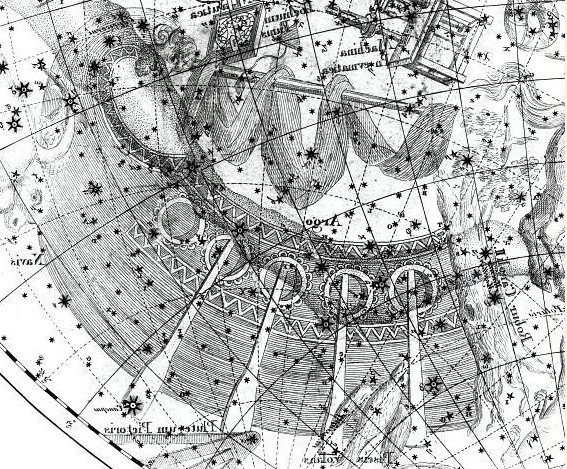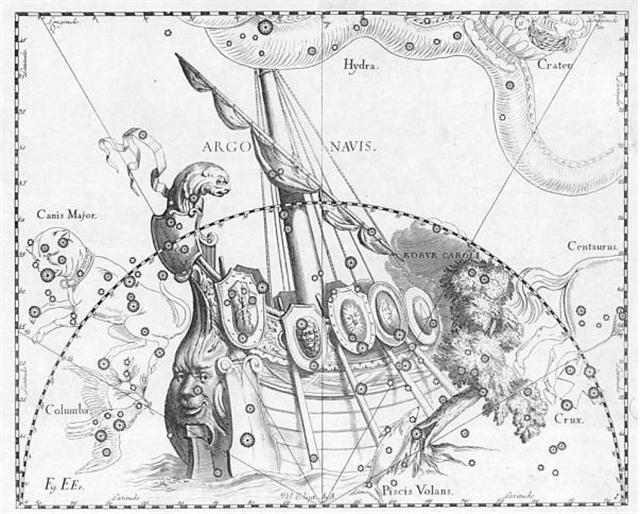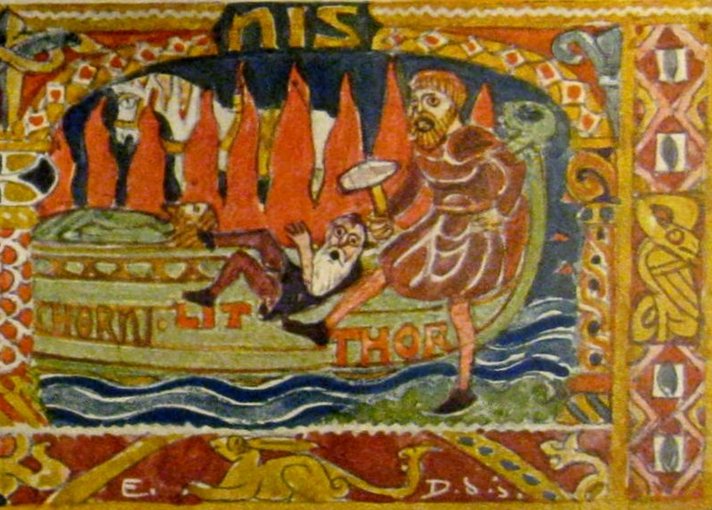There should be only the ghost of a mast remaining on Argo Navis because by the impact from colliding with the Oak its mast would have broken and fallen forward:
The Ghost of Jupiter (NGC3242 Hydrae) was placed later, though, and we can see the star q (mirrored p) Carinae straight above ω (Simiram) and up in the foliage of the falling oak:
... Robur Carolinum, Charles' Oak, the Quercia of Italy and the Karlseiche of Germany, was formally published by Halley in 1679 in commemoration of the Royal Oak of his patron, Charles II, in which the king had lain hidden for twenty-four hours after his defeat by Cromwell in the battle of Worcester, on the 3rd of September 1651 ... September 3 is day 246 counted from January 1. 246 = 2 * 123 = 6 * 41. If we should assume Halley was here using not the true heliacal dates but the day when a star returned to view again, then we could subtract 16 and find the true heliacal date for the star rising with the Sun when the king had lain hidden for 24 hours up on the Oak. 246 - 16 = 230 (August 18). In the G text this should be 4 days later than henua in Ga4-3 (due to the precession since Gregory XIII). And indeed Simiram was not hidden by the Oak:
Although q and p Carinae were hidden because they were higher up.
... 'In Upper Egypt', wrote Sir James G. Frazer in The Golden Bough, citing the observations of a German nineteenth-century voyager, 'on the first day of the solar year by Coptic reckoning, that is, on the tenth of September, when the Nile has generally reached its highest point, the regular government is suspended for three days and every town chooses its own ruler. This temporary lord wears a sort of tall fool's cap and a long flaxen beard, and is enveloped in a strange mantle. With a wand of office in his hand and attended by men disguised as scribes, executioners, and so forth, he proceeds to the Governor's house. The latter allows himself to be deposed; and the mock king, mounting the throne, holds a tribunal, to the decisions of which even the governor and his officials must bow. After three days the mock king is committed to the flames, and from its ashes the Fellah creeps forth ... September 10 (253) - 16 days = 237 (August 25) and this was where in rongorongo times the Extended Net was ending. 237 = 236 + 1 = 8 * 29½ + 1.
236 + 3 = 239 (August 27) would then be the day when the mock king was thrown onto the fire. The central day (August 26) was when in rongorongo times Shir (ρ Leonis, the 4th Son behind the Sun, Maru-sha-arkat-Sharru) rose with the Sun. ... Shir (ρ Leonis) was at haka-ua (Ga4-11), at the rain-making 4th Son behind the King. ... Naturally sharing the character of its constellation as the Domicilium Solia, in Euphratean astronomy it [Regulus] was Gus-ba-ra, the Flame, or the Red Fire, of the House of the East; in Khorasmia, Achir, Possessing Luminous Rays; and throughout classical days the supposed cause of the summer's heat, a reputation that it shared with the Dog-star ...
... The Mnajdra Temple is located on Malta and very ancient, dating to the time before the pyramids. Marija Gimbutas: 'To sleep within the Goddess's womb was to die and to come to life anew' ...
... Then I become aware of ... a presence - a faint, ghostly glimmering, like moonglow, that has appeared on the solstice stone. I don't know how long it lasts, a second or two only I would guess, but while it is there it seems less like a projection - which I know it to be - than something immanent within the stone itself. And it seems to function as a herald for it fades almost as soon as it has appeared and in its place the full effect snaps on - instantaneously. It wasn't there, and then it's there. As Chris had described, the effect does curiously resemble a poleaxe, or a flag on a pole, and consists of a 'shaft', narrow at the base but widening a little towards the top, running up the left hand side of the solstice stone, surmounted by a right-facing 'head' or 'flag'. An instant later an almond-shaped spot of light, like an eye, appears a few centimeters to the right of the 'flag' and the effect is complete. Weirdly - I do not claim it has any significance - this flag-on-a-pole symbol is the ancient Egyptian hieroglyph neter, meaning 'god', or 'a god' - and not to be understood at all in the Judaeo-Christian usage of that word but rather as a reference to one of the supernatural powers or principles that guide and balance the universe. Manifested here, in this strange Stone Age temple, it glows, as though lit by inner fire.' The 'poleaxe' had a 'shaft' which was narrow at its base but widening a little towards the top. Possibly the creator of the G text marked the presence, in Roman times, of Sirius - a kind of 'mock king in the night' for the daytime Sun because they shared the same cycle - by indicating a henua widening slightly towards the top:
Pollux wielded such a club and ρ Gemini was (perhaps) at the Chinese station Ghost - 16 days earlier than 'June 30. We can see the pair q Gemini followed by p (not ρ) Gemini on the belly of Pollux and not far from Wasat (δ, Middle):
... Its leading star is said to be 'q Cancri'. Strangely the internet site Chinese Astronomy never uses Greek letters for the stars, e.g. is Tejat Posterior (μ Gemini) referred to as 'm Gemini'. However, there is no Greek letter corresponding to the letter 'q'. Possibly the idea is to refer to the ancient Greek letter koppa, a reasonable sign for something dead and only living on in peoples' minds. There is no star q Cancri (or similar) according to Wikipedia ... ... Wasat (the Middle) is a name which agrees with its position in the middle of the year. If the year was measured by lunar synodic months (as 13 * 29½ = 383½ nights) its middle would have been at 191¾, close to the heliacal rising of Propus (the eye of the Red Bird). Earth's aphelion would have occurred around a week earlier ... Eventually I decided to guess 'q Cancri' - the leading star of the Ghost station - was referring to ρ Gemini, but maybe I was wrong. It could for instance have been q Gemini (not in my star list). Furthermore, counting when the mock king in Upper Egypt was 'committed to the flames' I did not above adjust with 4 days for the precession since the time of Gregory XIII. Would I have done so, then Matar (η Pegasi) would have been at the Full Moon: ... My reading of Ca13-2 as a leap night (February 29) relies partly on the name of the star Matar (which perhaps was visualized in Ca13-2), i.e. on the name of η Pegasi. Spanish matar means to kill (murder, butcher, extinguish, quench).
The quite similar glyph Ca13-1 would then represent the end of a non-leap year. Matar was according to Hevelius at the right front knee of the winged horse. Very close by was ο Pegasi which rose 1 day earlier than Matar. 'η [Pegasi] on the left forearm, is the Matar of Whitall's Planisphere, from Al Sa'd al Matar, the Fortunate Rain; as such, however, ο was included with it.' (Allen) The best translation of Matar could therefore be to 'quench', i.e. what rain will do to a fire. Turn it into smoke - as seems to have been visualized in the top right corner of the Cover:
Chilling rain is the opposite of the heat of the Sun.
... According to Gylfaginning, following the murder of Baldr by Loki, the other gods brought his body down to the sea and laid him to rest on the ship. They would have launched it out into the water and kindled a funeral pyre for Baldr but were unable to move the great vessel without the help of the giantess Hyrrokkin, who was sent for out of Jötunheim. She then flung the ship so violently down the rollers at the first push that flames appeared and the earth trembled, much to the annoyance of Thor. Along with Baldr, his wife Nanna was also borne to the funeral pyre after she had died of grief. As Thor was consecrating the fire with his hammer Mjolnir, a dwarf named Litr began cavorting at his feet. Thor then kicked him into the flames and the dwarf was burned up as well ... ... The leap day was introduced as part of the Julian reform. The day following the Terminalia (February 23) was doubled, forming the 'bis sextum - literally 'double sixth', since February 24 was 'the sixth day before the Kalends of March' using Roman inclusive counting (March 1 was the 'first day') ... Possibly the Litr dwarf (little man) represented March 1, which before the Julian reform might have corresponded to ¼ of a day, creating a year with 365¼ days. |
|||||||||||||||||||||||||||||||||||||||||||||||||||||||||||||||||||||||||||||||||||||||||||||||||||||||||||||||||||||||||||||||||||||||||||||||||||||||||||||||||||||||||||||||||||||||||||||||||||||||||||||||||||||||||||||||||||||||||||||||||||||||||||||||||||||||||


.jpg)














.jpg)









